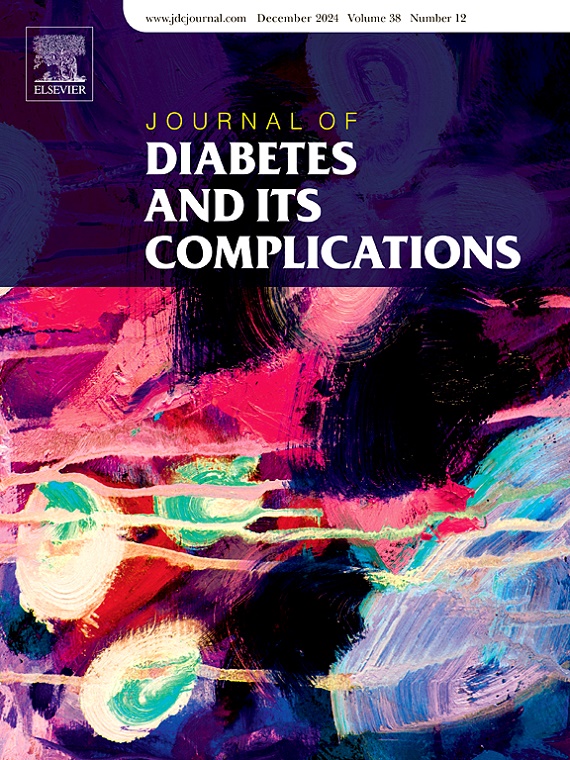Physical activity and albuminuria in individuals recently diagnosed with type 2 diabetes
IF 3.1
3区 医学
Q3 ENDOCRINOLOGY & METABOLISM
引用次数: 0
Abstract
Aims
We aimed to investigate the association between objectively measured physical activity and the presence and development of albuminuria in individuals recently diagnosed with type 2 diabetes at baseline.
Methods
This study was based on data from The Danish Centre for Strategic Research in Type 2 diabetes cohort (N = 832). We assessed moderate to vigorous physical activity (MVPA) and sedentary time by 24-hour dual-monitor accelerometry at baseline and 4-years follow-up and investigated the association with albuminuria, defined as urine albumin/creatinine-ratio (UACR) ≥30 mg/g, measured from a urine sample. The odds ratio (OR) for the presence and development of albuminuria were investigated using multiple logistic regressions.
Results
We found an inverse association between baseline MVPA and both presence (OR: 0.82; 95 % CI: 0.69–0.98) and incidence of albuminuria (OR: 0.74; 95 % CI: 0.59–0.94), independent of known confounding factors. However, sedentary time was not significantly associated with increased development of albuminuria. Moreover, neither decrease in MVPA (OR: 0.79; 95 % CI: 0.42–1.49) nor increase in sedentary time (OR: 1.03; 95 % CI: 0.98–1.09) were significantly associated with development of albuminuria from baseline to 4-years follow-up.
Conclusions
Our findings demonstrate an inverse association between baseline MVPA and development of albuminuria in individuals recently diagnosed with type 2 diabetes. An increase in MVPA from baseline to follow-up inferred 21 % lower incidence of albuminuria after 4-years follow-up, albeit insignificant, likely due to the relatively small sample size at follow-up and the lack of larger changes in physical activity.
Clinical trial registration number
NCT02015130
最近诊断为2型糖尿病的个体的身体活动和蛋白尿
目的:我们旨在调查客观测量的体力活动与最近诊断为2型糖尿病的个体在基线时蛋白尿的存在和发展之间的关系。方法本研究基于丹麦2型糖尿病战略研究中心的队列数据(N = 832)。我们在基线和4年随访时通过24小时双监测加速度计评估了中度至剧烈身体活动(MVPA)和久坐时间,并调查了与蛋白尿的关系,定义为尿白蛋白/肌酐比(UACR)≥30 mg/g,从尿液样本中测量。使用多元logistic回归分析了蛋白尿存在和发展的比值比(OR)。结果我们发现基线MVPA与两者的存在呈负相关(OR: 0.82;95% CI: 0.69-0.98)和蛋白尿发生率(OR: 0.74;95% CI: 0.59-0.94),独立于已知的混杂因素。然而,久坐时间与蛋白尿的增加并无显著关联。此外,MVPA也没有下降(OR: 0.79;95% CI: 0.42-1.49),也不会增加久坐时间(OR: 1.03;95% CI: 0.98-1.09)与基线至4年随访期间蛋白尿的发生显著相关。结论:我们的研究结果表明,在新近诊断为2型糖尿病的个体中,基线MVPA与蛋白尿的发展呈负相关。从基线到随访时MVPA的增加推断出4年随访后蛋白尿发生率降低21%,尽管不显著,可能是由于随访时样本量相对较小,并且缺乏体力活动的较大变化。临床试验注册号:bernct02015130
本文章由计算机程序翻译,如有差异,请以英文原文为准。
求助全文
约1分钟内获得全文
求助全文
来源期刊

Journal of diabetes and its complications
医学-内分泌学与代谢
CiteScore
5.90
自引率
3.30%
发文量
153
审稿时长
16 days
期刊介绍:
Journal of Diabetes and Its Complications (JDC) is a journal for health care practitioners and researchers, that publishes original research about the pathogenesis, diagnosis and management of diabetes mellitus and its complications. JDC also publishes articles on physiological and molecular aspects of glucose homeostasis.
The primary purpose of JDC is to act as a source of information usable by diabetes practitioners and researchers to increase their knowledge about mechanisms of diabetes and complications development, and promote better management of people with diabetes who are at risk for those complications.
Manuscripts submitted to JDC can report any aspect of basic, translational or clinical research as well as epidemiology. Topics can range broadly from early prediabetes to late-stage complicated diabetes. Topics relevant to basic/translational reports include pancreatic islet dysfunction and insulin resistance, altered adipose tissue function in diabetes, altered neuronal control of glucose homeostasis and mechanisms of drug action. Topics relevant to diabetic complications include diabetic retinopathy, neuropathy and nephropathy; peripheral vascular disease and coronary heart disease; gastrointestinal disorders, renal failure and impotence; and hypertension and hyperlipidemia.
 求助内容:
求助内容: 应助结果提醒方式:
应助结果提醒方式:


